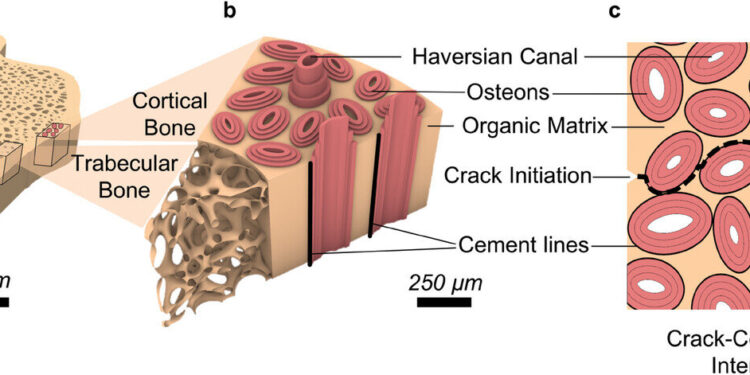Cortical bone architecture. a) Schematic cross-section of human femur bone illustrates dense outer cortical bone and porous inner trabecular bone. b) Cortical bone architecture shows the presence of weak cement lines surrounding tubular osteons, leading to c) crack-cement line interaction, providing a path for in-plane crack deflection from a straight brittle fracture as a hardening mechanism. Credit: Advanced materials (2024). DOI: 10.1002/adma.202313904
Inspired by the architecture of the hard outer layer of human bones, Princeton engineers have developed a cement-based material that is 5.6 times more resistant to damage than its standard counterparts. The bio-inspired design allows the material to resist cracking and avoid sudden failure, unlike its conventional, brittle cement-based counterparts.
In a new article in the journal Advanced materialsThe research team led by Reza Moini, assistant professor of civil and environmental engineering, and Shashank Gupta, a third-year doctoral candidate, demonstrates that cement paste deployed with a tubular architecture can significantly increase resistance to crack propagation and improve the ability to deform without sudden failure.
“One of the challenges of engineering brittle building materials is that they fail suddenly and catastrophically,” Gupta said.
In brittle construction materials used in buildings and civil infrastructure, strength ensures the ability to support loads, while toughness supports resistance to cracking and damage propagation in the structure. The proposed technique addresses these issues by creating a material that is stronger than its conventional counterparts while maintaining its strength.
Moini said the key to the improvement lies in the targeted design of the internal architecture, balancing stresses at the crack front with the overall mechanical response.
“We use theoretical principles of fracture mechanics and statistical mechanics to improve the fundamental properties of materials ‘by design,'” he said.
The team took inspiration from human cortical bone, the dense outer shell of human femurs that provides strength and resists fracture. Cortical bone is made up of elliptical tubular components called osteons, loosely embedded in an organic matrix. This unique architecture deflects cracks around the osteons. This prevents abrupt failure and increases the overall resistance to crack propagation, Gupta said.
The team’s bio-inspired design integrates cylindrical and elliptical tubes into the cement paste that interact with propagating cracks.
“The material is expected to become less resistant to cracking when hollow tubes are incorporated,” Moini said. “We learned that by taking advantage of the geometry, size, shape and orientation of the tube, we can promote crack-tube interaction to improve one property without sacrificing another.”
The team found that such enhanced crack-tube interaction triggers a step-hardening mechanism, in which the crack is first trapped by the tube and then delayed in its propagation, leading to additional energy dissipation at each interaction and step.
“This stepwise mechanism is unique because each crack extension is controlled, preventing sudden, catastrophic failure,” Gupta said. “Instead of breaking all at once, the material resists progressive damage, making it much stronger.”
Unlike traditional methods that strengthen cement-based materials by adding fibers or plastics, the Princeton team’s approach relies on geometric design. By manipulating the structure of the material itself, they achieve significant strength improvements without the need for additional material.
In addition to improving fracture toughness, the researchers introduced a new method to quantify the degree of disorder, an important quantity for design. Drawing on statistical mechanics, the team introduced parameters to quantify the degree of disorder in architected materials. This allowed the researchers to create a numerical framework that reflects the degree of disorder in the architecture.
The researchers said the new framework offers a more accurate representation of material arrangements, moving toward a spectrum from ordered to random, beyond simple binary classifications of periodic and nonperiodic. Moini said the study distinguishes between approaches that confuse irregularity and perturbation with statistical disorders such as Voronoi tessellation and perturbation methods.
“This approach gives us a powerful tool to describe and design materials with a customized degree of disorder,” Moini said. “Using advanced manufacturing methods such as additive manufacturing can further enable the design of more disordered and mechanically favorable structures and enable the scaling of these tubular designs for civil infrastructure components with concrete.”
The research team has also recently developed techniques that enable high precision through robotics and additive manufacturing. By applying them to new architectures and combinations of hard and soft materials within the tubes, they hope to expand the possibilities for applications in construction materials.
“We’re just beginning to explore the possibilities,” Gupta said. “There are many variables to study, such as applying the degree of disorder to the size, shape and orientation of the tubes in the material. These principles could be applied to other brittle materials to design structures that are more resistant to damage.”
More information:
Shashank Gupta et al., Tubular architectural cement-based material inspired by strong cortical bone with disorder, Advanced materials (2024). DOI: 10.1002/adma.202313904
Provided by Princeton University
Quote: Team develops stronger concrete, inspired by bones (2024, September 16) retrieved September 16, 2024 from
This document is subject to copyright. Apart from any fair dealing for the purpose of private study or research, no part may be reproduced without written permission. The content is provided for informational purposes only.



